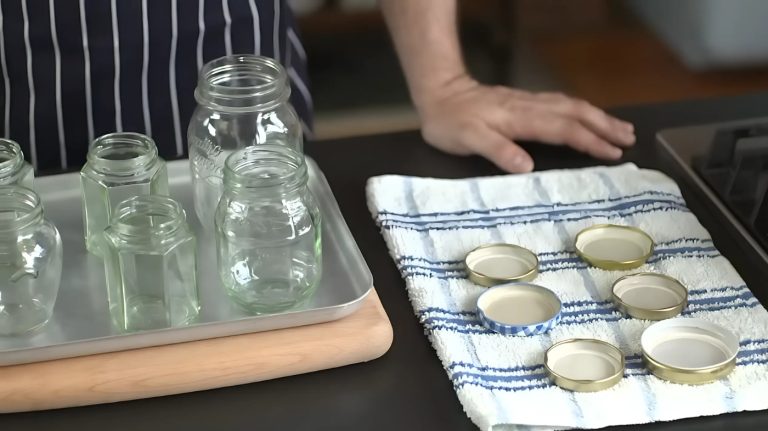How to Sanitize Mason Jars? Simple Steps for Safe Use
To sanitize mason jars, first inspect them for cracks or chips and remove any labels. Wash the jars with mild soap and a non-abrasive sponge, rinsing thoroughly.
Use the boiling water method by placing jars in a pot, covering them with water, and boiling for at least 10 minutes.
Alternatively, you can use the oven, bleach solution, or vinegar method for sanitization. Make certain the jars dry completely before storing to avoid re-contamination. You’ll find more helpful tips ahead.
Key Takeaways
- Inspect jars for cracks or chips and clean with mild soap and a non-abrasive sponge before sanitizing.
- Use the boiling water method by immersing jars in boiling water for at least 10 minutes to eliminate bacteria.
- Alternatively, sanitize jars in an oven at 200°F for 10-15 minutes for effective sterilization.
- Rinse jars thoroughly after using chemical sanitizers, like a bleach solution, to remove any residues.
- Air dry sanitized jars on a clean surface or in an oven set to 200°F for quick drying.
Essential Cleaning Supplies for Mason Jars
Cleaning Mason jars effectively requires a few essential supplies that guarantee thorough sanitation and maintenance. Here’s a concise list of must-have items:
| Cleaning Supply | Purpose |
|---|---|
| Mild Dish Soap | Removes grease and residue |
| Scrub Brush | Cleans the interior and exterior thoroughly |
| Hot Water | Rinses and soaks for sanitization |
In addition to these, having white vinegar helps eliminate scale and mineral deposits. You’ll also need towels for drying the jars post-cleaning.
Tongs are vital for handling hot jars, ensuring safety during your sanitization process. With these supplies, you’re well-equipped to clean your Mason jars effectively.
Additionally, using eco-friendly materials like Mason jars for various DIY projects helps promote sustainability.
Preparing Your Work Area
Before you begin sterilizing your Mason jars, it’s crucial to make certain your work area is impeccably clean to minimize the risk of contamination.
Start by thoroughly disinfecting your countertops to eliminate any potential bacterial transfer. Ascertain all dishcloths and towels are clean and dry, as using dirty materials can compromise your efforts.
Proper sterilization enhances safety during the canning process, so be sure to keep your area organized and hygienic.
Clear away any clutter to allow for easy movement while you work. You’ll also need a rack or tray to support the jars during the sterilization process.
Remember, using a large, clean pot or boiling water canner is essential, so check that it’s free from residue before you start. Keeping your area organized and hygienic sets the stage for successful jar sterilization.
Inspecting and Cleaning Jars
Start by thoroughly inspecting your jars for any cracks or chips; discard any that are damaged.
Next, remove all labels and adhesive residue to guarantee a clean surface. Cleaning is essential for healthy ferments to ensure that any residual contaminants are eliminated.
Additionally, using cleaning process techniques like soaking lids in warm, soapy water can enhance the sanitation of your jars. Finally, wash the jars with mild soap and a non-abrasive sponge to eliminate any remaining dirt.
Check for Cracks
Inspecting your mason jars for cracks and chips is essential to ensure safe food preservation. Start by examining new jars closely, as hidden flaws may be present even if they seem perfect.
Remember that inspecting jars can prevent unexpected canning failures and loss of food. Pay attention to circular cracks at the bottom, which can lead to breakage.
Check the jar’s mouth for any chips, as these can hinder proper sealing. The seam at the bottom of the jar is also a potential weak spot, so inspect it carefully.
Remember, even small imperfections can compromise the glass under pressure. If you find any cracks or chips, discard the jars immediately to prevent failures during storage.
Remove Labels Thoroughly
Once you’ve verified your mason jars are free from cracks and chips, the next step involves removing any labels.
Start by soaking the jars in warm, soapy water to loosen the labels. If that doesn’t work, apply rubbing alcohol to dissolve the adhesive, making it easier to wipe away the labels.
You can also use heat from an oven, microwave, or hairdryer to melt the glue. Additionally, freezing jars can be a simple method to help loosen stubborn labels by making the glue brittle.
It’s important to inspect the jars for any signs of rust formation after label removal, as this can compromise their safety.
Alternatively, try the freezing method by placing jars in the freezer, which can stiffen the adhesive. After removing the labels, inspect the jars carefully for any sticky residue or visible debris.
Confirm all remnants are gone, as even small amounts can affect the sanitization process.
Wash With Soap
To effectively wash your mason jars, begin by using mild dish soap and warm water. Inspect each jar for chips, cracks, or deep scratches before cleaning.
Use a non-abrasive sponge to scrub all surfaces, especially the rims and inner areas, making sure no grime remains.
Rinse thoroughly to eliminate soap residue. Many jars are still usable after cleaning, which means they can continue to serve their purpose even if they were stored in a barn or basement.
Here’s a quick reference table for the cleaning process:
| Step | Action | Tools Needed |
|---|---|---|
| 1. Inspect | Check for damage | Visual inspection |
| 2. Wash | Scrub with soap and water | Non-abrasive sponge |
| 3. Rinse | Remove all soap | Clean running water |
| 4. Dry | Use a clean dishcloth | Drying cloth |
| 5. Inspect again | Confirm jars are clean | Visual inspection |
Discard any jars showing signs of damage. Clean jars lay the foundation for effective sanitization.
The Boiling Water Method
When you need to guarantee your Mason jars are properly sanitized, the boiling water method stands out as a reliable and straightforward option.
Start by washing your jars with hot soapy water, then rinse them thoroughly. Place the jars upright in a large pot or canner fitted with a rack, ensuring they don’t touch.
Fill the pot with water, covering the jars by at least one inch. Bring the water to a rolling boil; maintain a high heat for at least 10 minutes if you’re at sea level.
For higher elevations, add one minute of boiling time for every 1,000 feet. It’s important to ensure all jars are clean before sterilization to achieve optimal results. Use jar lifters or tongs to carefully remove the jars and let them cool on a clean dish towel.
Alternative Sanitization Techniques
While the boiling water method effectively sanitizes Mason jars, there are several alternative techniques you can consider for your canning needs.
One option is the oven method, where you heat jars at 200°F (90°C) for 10-15 minutes. This high temperature effectively kills bacteria and is convenient if you’re already using your oven. You can also use chemical sanitization techniques.
For instance, soak jars in a bleach solution (1 part bleach to 10 parts water) for 10-15 minutes, but remember to rinse thoroughly.
Alternatively, a vinegar solution (1 part vinegar to 2 parts water) can be used for a more environmentally friendly option. Finally, consider exposing jars to UV light for 10-15 minutes to eliminate microorganisms.
Proper Drying of Jars
Properly drying your sanitized Mason jars is essential for guaranteeing they remain free from contamination. You can choose from several effective drying methods.
Air drying is a natural option; just leave the jars on a clean surface in a well-ventilated area. If you want quicker results, use lint-free towels but be cautious of lint contamination.
Alternatively, place jars in an oven set to 200°F for 15-20 minutes to expedite drying. A drying rack also promotes air circulation for efficient drying. Always verify jars are placed on a sanitized surface to prevent re-contamination.
Storing Sanitized Jars
Storing your sanitized Mason jars correctly is essential for maintaining their cleanliness and readiness for use. Make sure that jars aren’t touching each other to prevent breakage.
Choose a dry area for storage, as moisture can compromise their integrity. Prepare your shelves by lining them with foam or a protective layer to minimize chipping.
Store rings and seals separately in their own containers, avoiding contamination until you’re ready to fill the jars.
Remember, sanitized jars can be stored for several months, but for best results, use them soon after sterilization.
Regularly inspect your jars for cracks or chips, and keep them away from direct sunlight and extreme temperatures to maintain their quality.
Frequently Asked Questions
Can I Reuse Sanitized Jars for Multiple Canning Sessions?
Yes, you can reuse sanitized jars for multiple canning sessions, as long as you properly inspect and sanitize them each time.
Verify there are no cracks or chips before each use, and clean the jars with hot soapy water to remove any residue. If they’re in good condition, you can safely use them again. Always use new lids to maintain a proper seal for your canned goods.
What if My Jars Are Dishwasher Safe?
Did you know that nearly 70% of households own a dishwasher? If your jars are dishwasher safe, you can easily sanitize them using the sanitize cycle.
Just make sure your dishwasher reaches at least 160°F (71°C) and place the jars upside down on the top rack for ideal water circulation.
Remember to remove any labels and clean the jars beforehand. This method effectively reduces bacteria, ensuring your jars are ready for use.
How Do I Know if My Jars Are Properly Sanitized?
To know if your jars are properly sanitized, visually inspect them for any debris or damage. Verify they’ve been boiled for at least 10 minutes or heated in the oven at 250°F for 30 minutes.
Check that they’re dry and free from moisture, which can promote bacterial growth. After sanitization, avoid touching the insides and confirm that they remain intact before use. Regular inspection is essential for maintaining safety and quality.
Is It Necessary to Sanitize Jar Lids as Well?
Yes, it’s necessary to clean jar lids, but you shouldn’t sanitize them like the jars. Instead, wash them in hot soapy water and rinse thoroughly.
Avoid boiling lids, as it can damage the rubber seal. Make sure you handle them carefully and let them dry on a clean surface. Using new lids is always a good practice to guarantee a proper seal and prevent contamination in your preserved foods.
Can I Sanitize Jars in the Microwave?
Yes, you can sanitize jars in the microwave. Start by cleaning them thoroughly with hot, soapy water and guarantee all residues are removed.
Fill each jar with water, leaving 1-2 inches of headspace. Heat them for 2-3 minutes on full power until the water boils. Always use oven mitts when handling hot jars and cool them upside-down on a clean towel.
Ensure Freshness and Safety with Proper Mason Jar Sanitization
Sanitizing your mason jars is like laying a solid foundation for a house; it guarantees your preserves stay fresh and safe. By following the steps outlined, you’ve not only protected your food but also extended its shelf life.
Remember to store your sanitized jars in a clean, dry place to maintain their readiness for your next canning adventure. With this preparation, you’ll be well-equipped to tackle any recipe that comes your way. Happy canning.







